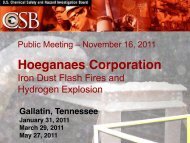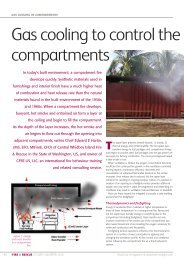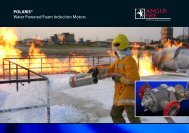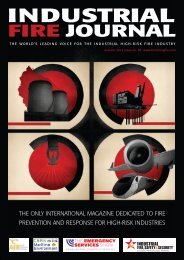New Perspectives on the Critical Velocity for Smoke Control
New Perspectives on the Critical Velocity for Smoke Control
New Perspectives on the Critical Velocity for Smoke Control
Create successful ePaper yourself
Turn your PDF publications into a flip-book with our unique Google optimized e-Paper software.
Fourth Internati<strong>on</strong>al Symposium <strong>on</strong> Tunnel Safety and Security, Frankfurt am Main, Germany, March 17-19, 2010<br />
Fire Size (MW) Distance Upstream of Fire (m) Distance Downstream of Fire (m)<br />
5 - -<br />
20 10 40<br />
50 20 80<br />
100 30 120<br />
Table 1: Distances over which Jet Fans may be c<strong>on</strong>sidered as destroyed during Fire [12]<br />
It is certainly possible that a tunnel ventilati<strong>on</strong> system may ‘blow too hard’ and actually increase <strong>the</strong><br />
fire heat release rate from a burning vehicle. Fig. 2 depicts <strong>the</strong> possible enhancement factors ‘k’ of<br />
peak fire heat release rates from burning heavy goods vehicles (HGVs), as a functi<strong>on</strong> of tunnel<br />
ventilati<strong>on</strong> velocity. Values of ‘k’ above unity indicate an enhancement in <strong>the</strong> fire heat release rate.<br />
The two curves shown are <strong>for</strong> single-lane and dual-lane tunnels The exact physical processes involved<br />
in <strong>the</strong> fire heat release rate enhancement are not well understood, but could involve providing<br />
additi<strong>on</strong>al oxygen to partially shielded fires within a burning HGV. Apart from enhancing <strong>the</strong> peak<br />
fire heat release rate, <strong>the</strong>re is also <strong>the</strong> possibility of a higher fire growth rate within <strong>the</strong> burning<br />
vehicle, and of fire spread to o<strong>the</strong>r vehicles within <strong>the</strong> tunnel.<br />
Fig. 2: Fire Heat Release Rate Enhancement Factors (after Carvel et al [11])<br />
In order to avoid <strong>the</strong> drawbacks of excessive air velocities and possible fire enhancement, a c<strong>on</strong>trol<br />
system may be required to m<strong>on</strong>itor <strong>the</strong> tunnel air velocities and feed <strong>the</strong>se air velocities back to an<br />
automatic c<strong>on</strong>trol system. Such a ventilati<strong>on</strong> c<strong>on</strong>trol system is c<strong>on</strong>sidered standard in a number of<br />
European countries including Switzerland and Austria, but not in <strong>the</strong> United Kingdom, <strong>for</strong> example.<br />
The Austrian design standard RVS 09.02.31 [13] specifies that <strong>the</strong> l<strong>on</strong>gitudinal ventilati<strong>on</strong> system<br />
should reduce <strong>the</strong> air velocity in unidirecti<strong>on</strong>al traffic to between 1.5 m/s to 2 m/s, and <strong>for</strong><br />
bidirecti<strong>on</strong>al traffic to a value between 1 m/s and 1.5 m/s. The Austrian design standard does not<br />
however menti<strong>on</strong> any requirement to meet <strong>the</strong> critical air velocity <strong>for</strong> smoke c<strong>on</strong>trol.<br />
For unidirecti<strong>on</strong>al traffic without c<strong>on</strong>gesti<strong>on</strong>, <strong>the</strong> German RABT guidelines [14] require a minimum<br />
velocity of <strong>the</strong> air flow exceeding <strong>the</strong> critical velocity <strong>for</strong> smoke c<strong>on</strong>trol.<br />
The World Road Associati<strong>on</strong>’s report <strong>on</strong> “Operati<strong>on</strong>al Strategies <strong>for</strong> Emergency Ventilati<strong>on</strong>” [15]<br />
provides three different cases <strong>for</strong> operati<strong>on</strong>al c<strong>on</strong>trol of <strong>the</strong> tunnel air velocity in case of an incident,<br />
as summarised in Table 2. Although <strong>the</strong> text of <strong>the</strong> report does refer to <strong>the</strong> critical air velocity <strong>for</strong><br />
smoke c<strong>on</strong>trol, it does counsel that while high flowrates may have <strong>the</strong> advantage of reducing<br />
temperature and decreasing toxicity, <strong>the</strong>y may lead to higher fire heat release rates and will<br />
completely destroy any smoke stratificati<strong>on</strong>.<br />
424



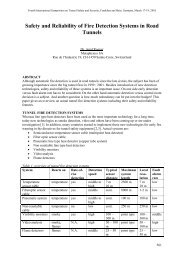
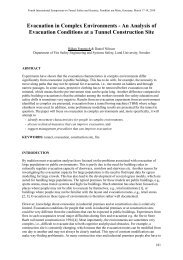

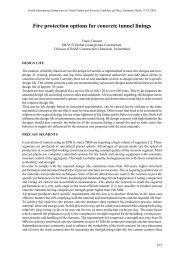
![30-37 TunnelsREV[1]rev.qxd - Industrial Fire Journal](https://img.yumpu.com/22237435/1/184x260/30-37-tunnelsrev1revqxd-industrial-fire-journal.jpg?quality=85)
